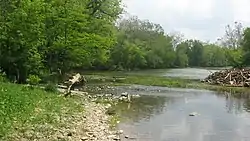Little River (Indiana)
The Little River is a 22.6-mile-long (36.4 km)[1] stream in Allen and Huntington counties in northeastern Indiana. A tributary of the Wabash River, it is sometimes called the "Little Wabash", which may cause it to be confused with the Little Wabash River of Illinois. The river drains an area of 287.9 square miles (746 km2).[2]

The Little River follows the Wabash-Erie Channel or "sluiceway," a remnant of the Maumee Torrent that drained ancient Glacial Lake Maumee at the end of the Wisconsin glaciation, and joins the Wabash just west of Huntington.
The Little River is part of the Wabash River Heritage Corridor, created by the Indiana General Assembly in 1991 to commemorate the historic portage that linked the Wabash River watershed with that of Lake Erie.
Its source is located approximately 1 mile (1.6 km) southwest of the Ardmore Knolls neighborhood of Fort Wayne, at 41°1′13″N 85°12′4″W, and its mouth is located in Huntington at 40°52′35″N 85°31′51″W,[3] at a park known as the Forks of the Wabash.[4]
At Huntington, Indiana, the Little River has a mean annual discharge of 256 cubic feet per second.[5]
See also
References
- U.S. Geological Survey. National Hydrography Dataset high-resolution flowline data. The National Map Archived 2012-03-29 at the Wayback Machine, accessed May 19, 2011
- U.S. Geological Survey. National Hydrography Dataset, area data covering Little River watershed, 10-digit Hydrologic Unit Codes 0512010109, 0512010110, and 0512010111. The National Map Archived 2012-03-29 at the Wayback Machine, retrieved 2015-10-24
- U.S. Geological Survey Geographic Names Information System: Little River
- Gernand, Jean, and Mary Kelsay. National Register of Historic Places Inventory/Nomination: Chief Richardville House and Miami Treaty Grounds. National Park Service, 1978-10, 2.
- https://waterdata.usgs.gov/in/nwis/uv/?site_no=03324000&PARAmeter_cd=00065,00060,62614,00010